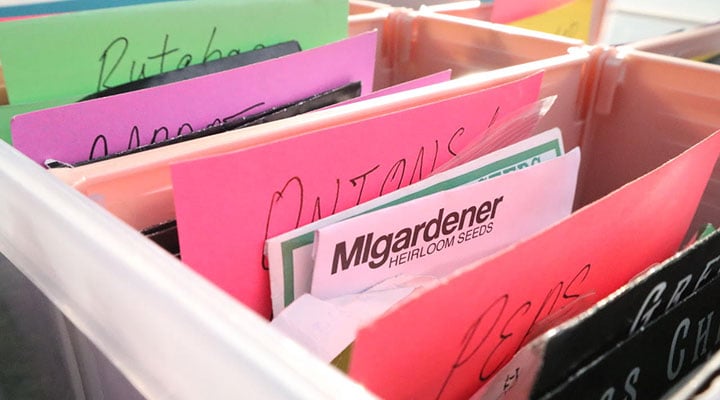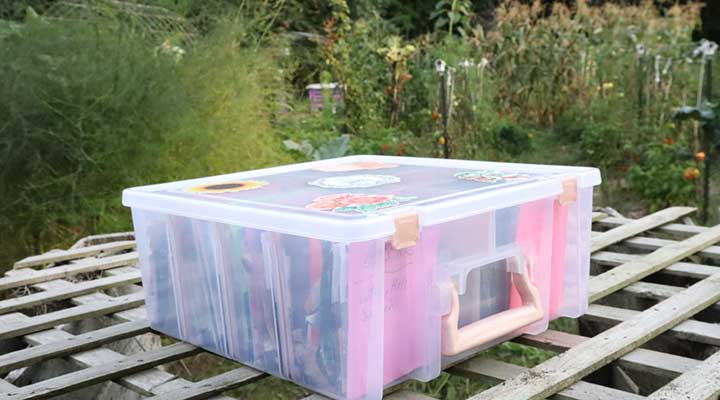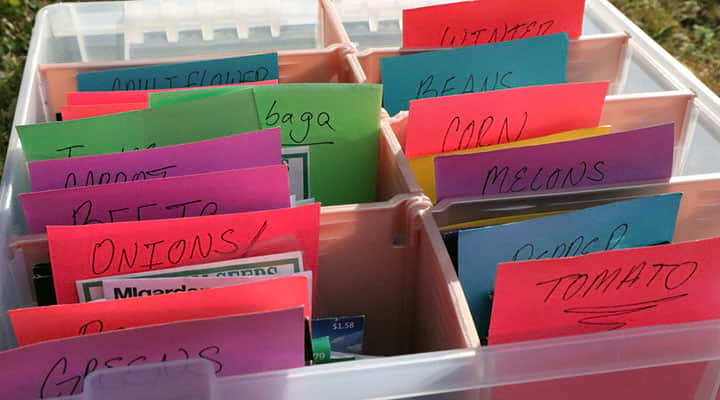
How to Store Seeds
Mar 31, 2023 / Liset Marquez
When Alexa Sandella began gardening six years ago she didn’t have to worry about how to store seeds—because she didn’t have any.
But over the years she was gifted seed packets, participated in a seed swap, and even got some for free from her library’s seed catalog collection.
Last year, while she was at home more because of the pandemic, Sandella ramped up her gardening adding more seeds. She realized her collection had grown from 20 seed packets to more than 230 seeds packets.
“I had seed packets all over the place, in baggies, drawers and some in my garage. I didn’t even know what I had to be able to plan for next year,”; said Sandella, who has a 3,000-square foot garden in northeast Ohio.
Sandella knew she needed to get serious about how to store seeds. She’s not alone.
“With more time at home, many consumers took up gardening as a hobby,”; said Venelin Dimitrov, senior product manager for Burpee, a seed and plant company based in Pennsylvania.
In fact, Burpee estimated more than 18 million new gardeners in 2020.
Read on to learn the best seed storage and organization tips!
What is the Best Way to Store Seeds?

“The best way to store seeds is in their original packages if possible, or in a labeled envelope in a jar or a cookie tin with a tight-fitting lid, protected from light and moisture,”; said Dimitrov.
If you’re planning to store seeds you’ve harvest from a recent crop, Sandella suggests you take a couple of extra precautions.
For squash, she scoops out the seeds and washes in a colander. She’ll then layout them out on a paper towel to air dry for a couple of days.
For tomatoes and peppers, Sandella scoops out the seeds and puts them in a glass of water for about two days to help break down the gel around the seeds. She’ll then wash them in a mesh strainer and dry for a couple of days on a towel or coffee filter.
The key is to make sure the seeds are completely dry before storage, otherwise they can get moldy.
Dimitrov has a pro tip: place rice or powdered milk in the storage container, to absorb moisture.
Once the seeds are dry, store them in a plastic bag or small envelope, similar in size to seed packets.
Make sure to add the date to the sleeves Dimitrov said. This will help you determine how long you can store the seeds.
“The longevity of seeds depends on the type of seed, but in general, even if you use careful saving techniques, no seeds last forever,”; he said.
For example, Dimitrov said Spinach, lettuce, parsnip, and corn seeds are generally only viable for about a year, while bean seeds may germinate after two years. Additionally, the seeds of many squash varieties are often good for three or four years, he added.
What is the Best Container to Store Seeds?

Initially, Sandella used a cardboard photo box with a snap lid to store her seeds.
The type of container is also important for keeping out water. If any water gets in the seeds then it’s going to cause them to germinate and you don’t want that to happen in storage.
She went to her local craft store and found an art storage container that would hold her growing collection. The container has a snap-tight buckles and handle so it’s easy to carry around the garden.
“I liked the size and it was big enough to hold my seed packets. It also came with removable dividers to organize my collection into sections,”; said Sandella, who documented her seed storage process on her YouTube account Sandals and Steel-Toes.
She advises novice gardeners to not worry about getting too fancy with seed storage at the start. A repurposed recipe box or small basket can also do the job. Other storage options also include photo albums, she said.
But as your seed collection grows, you’ll have to rethink your storage strategy and find something larger. Sandella has seen other gardeners use plastic photo organizer bins which come with several 4×6 plastic cases inside. Each inner cases is meant to hold photos and can hold quite a few seed packets.
“My storage bin is pretty handy,”; Sandella said. “I carry the whole case out and we go to work together.”;
How do You Store and Organize Seeds?

Every gardener has their own preference for how they keep their seed collection organized, said Dimitrov.
This is the work of stashing seeds so they’re not only out of the light but creating a system so that you can easily find what you’re looking for.
“One general tip of advice is in order to stay organized; it’s recommended to keep your seeds in a seed library,”; he said.
Sandella suggests setting aside at least two hours to organize a large seed collection. She starts by gathering all her packets in one space and began inspecting to see if any needed to be tossed out. She groups duplicate and similar seeds.
She also removes any seeds she had in plastic bags or containers around her house and put them in sleeve packets which she bought online and she labels.
Even though her new storage container came with dividers she took some craft paper and added additional dividers to organize by seed type. You can also keep different varieties together in a bin with a binder clip or rubber band.
If you are going to organize your seeds by season, consider buying one storage bin for plants that grow in cooler temperatures and another one for your heat-loving plants.
“That way you have an easy way to grab a seasonable plant that you want to grow,”; she shared.
Sandella, who works as technical project manager full-time, also created an Excel spreadsheet of the different varieties and how long it takes for them to grow.
“I’ve been organized throughout the year,”; she said of her storage bin. “It’s been really easy to find what I need.”;
If you’re looking for more gardening tips, read on to learn these cool Garden Tool Storage Tips. We also have great Vegetable Gardening Tips for Beginners.
These DIY tips will show you How to Make a Garden Path to Sweeten Your Outdoor Space!






